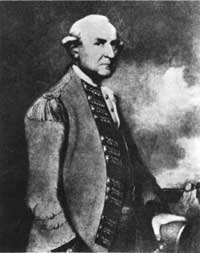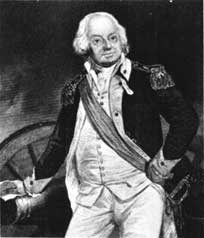|
GUILFORD COURTHOUSE National Military Park |
 |
 Lord Charles Cornwallis, Lieutenant General in command of the British forces in the South. After a portrait by John Singleton Copley. |
 Maj. Gen. Benjamin Lincoln, who surrendered his American Army to British forces under Sir Henry Clinton, at Charleston, S.C., in May 1780. From a lithograph donated to the National Park Service by the Guilford Battle Ground Company. |
Sweep Through Georgia
Accordingly, an expeditionary force sent to Georgia under Sir Archibald Campbell captured Savannah during the last week of 1778. With the assistance of Gen. Augustine Prevost, who had marched northward from Florida with 2,000 men, Campbell completed the conquest of Georgia during the first half of 1779. In April, Prevost entered South Carolina and devastated it; but, failing to take Charleston, the key city of the region, he was compelled to return to Georgia. In September, the Americans, aided by a French fleet, attempted to retake Savannah, but they were repulsed with severe losses.
Siege of Charleston
In December Sir Henry Clinton, commander in chief of British forces in America, sailed south from New York with 8,000 men. He landed at Tybee Island at the mouth of the Savannah River. After obtaining reinforcements from Prevost, he proceeded against Charleston. Gen. Benjamin Lincoln, the American commander, should have abandoned Charleston, but instead he collected all the troops he could and shut himself up in the city, where he surrendered on May 12, 1780, after a brief siege.
Having obtained his objective, Clinton returned to New York, leaving the Earl of Cornwallis in command, with the task of consolidating the gains in the South and continuing the conquest. Cornwallis established a series of military posts throughout South Carolina, but he was constantly annoyed and harassed by guerrilla raids led by such famed partisan leaders as Francis Marion, Thomas Sumter, Andrew Pickens, and Otis Williams. Charleston remained the British base of operations and supply depot, while activity in the interior centered at Camden.

|
|
Last Modified: Mon, Dec 2 2002 10:00:00 am PDT |


